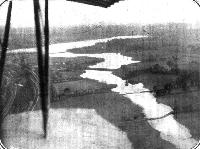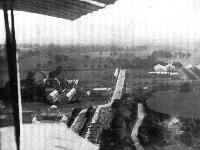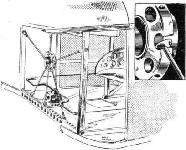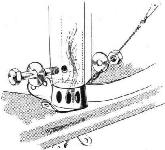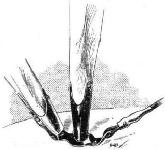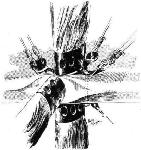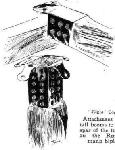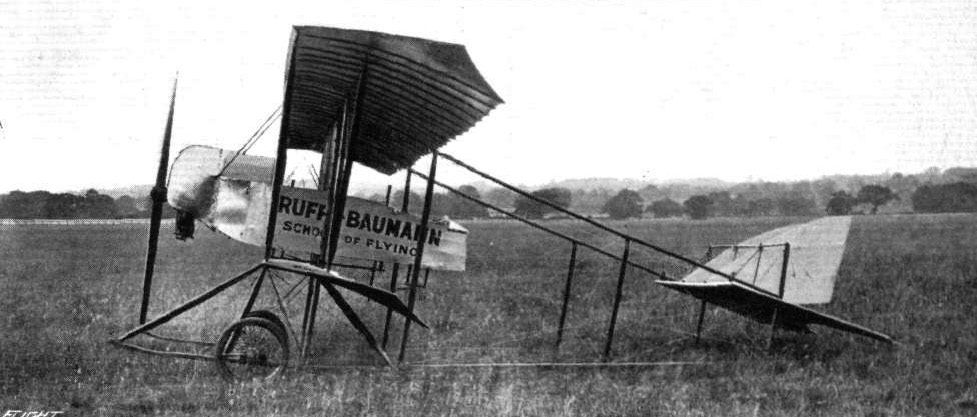
Описание
Страна: Великобритания
Год: 1914
Варианты
- Caudron - C / D / E - 1912 - Франция
- Schwade - Caudron-Copy Biplane - 1912 - Германия
- Caudron - G.3 - 1913 - Франция
- Caudron - Type J - 1913 - Франция
- James - biplane - 1914 - Великобритания
- Ruffy-Baumann - biplane - 1914 - Великобритания
- J.Bruce British Aeroplanes 1914-1918 (Putnam)
- M.Goodall, A.Tagg British Aircraft before the Great War (Schiffer)
- Журнал Flight
-
Журнал - Flight за 1915 г.
The new 50 h.p. Gnome-Caudron type biplane, built by the Ruffy-Baumann School of Flying, Hendon, and used for tuition and brevet purposes. The same firm are now constructing other machines of similar type of 50 and 60 h.p.
-
Журнал - Flight за 1916 г.
Three-quartet front view of the 60 h.p. Ruffy-Baumann school biplane.
-
Журнал - Flight за 1916 г.
Three-quarter rear view of the 60 h.p. Ruffy-Baumann school biplane.
-
Журнал - Flight за 1916 г.
AN EVENING SCENE AT HENDON. - E. Baumann on a Ruffy-Baumann with a passenger.
-
Журнал - Flight за 1915 г.
THE WELSH HARP RESERVOIR IN FLOOD AFTER THE RECENT RAINS. - A snapshot from the Ruffy-Baumann biplane at a height of 1,000 ft.
-
Журнал - Flight за 1915 г.
ABOVE HENDON AERODROME. - A snap from the Ruffy-Baumann biplane at 500 ft. above the flying ground. The road seen prominently in the photograph is part of Collindale Avenue.
-
Журнал - Flight за 1915 г.
Some of the pupils of the Ruffy-Baumann School of Flying and three of the machines at present in use. This number will shortly be increased as the Works are busy on the production of several biplanes.
-
H.Cowin - Aviation Pioneers /Osprey/
A future fighter ace in the making. This image of the nineteen-year-old Second Lieutenant Albert Ball shows him standing in front of a Caudron G III of the Ruffy-Baumann School of Flying at Hendon during the summer of 1915. As was the British Army practice of the day, any officer wishing to transfer to the RFC had to pay for his own initial flying training, only being reimbursed once he had gained his Aero Club Aviator's Certificate. Born in August 1896, Albert Ball was barely eighteen when commissioned into the Sherwood Forresters during October 1914. Determined to fly, Ball gained his Aviator's Certificate on 15 October 1915. Further flying training with the RFC brought Ball his military wings in January 1916. Ball joined his first operational unit, No 13 Squadron, RFC, at Vert Galand, France, flying the BE 2c, in February 1916. Three months later, in May 1916, Ball joined No 11 Squadron, RFC, a single-seater unit at Savy, flying Nieuport 16s and Bristol Scouts. Between then and October 1916, when Ball was sent home to instruct he had been promoted to Lieutenant and credited with a confirmed 31 'kills' in April 1917, Ball, now a Captain and 'A' Flight Commander of the newly formed, crack No 56 Squadron, RFC, flying SE 5s, returned to the Western Front. In the less than two week period between 23 April 1917 and 6 May 1917, Ball was to down a further 13 of the enemy, to bring his total confirmed score to 44. On the following evening of 7 May 1917, Ball's SE 5a was seen to break out of cloud base in an inverted spin and crash. Although Ball had been in combat with machines of Jasta II, his death has been attributed to vertigo, or being knocked unconscious by a loose Lewis gun ammunition drum - the former being less likely than the latter which was a known hazard to Nieuport and SE 5 pilots. Ball, already the holder of a Military Cross, Distinguished Service Order and Bar, was posthumously awarded Britain's highest military award for gallantry, the Victoria Cross.
-
Журнал - Flight за 1916 г.
The rear engine support of the Ruffy-Baumann biplanes. Inset is shown the ball joint of the bracing rods to the collar on the engine shaft.
-
Журнал - Flight за 1916 г.
Sketch showing how the lower longerons are secured to the inner interplane struts on the Ruffy-Baumann biplanes.
-
Журнал - Flight за 1916 г.
Interplane strut sockets on the Ruffy-Baumann biplanes.
-
Журнал - Flight за 1916 г.
Attachment of the chassis struts to the leading edge on the Ruffy-Baumann biplanes.
-
Журнал - Flight за 1916 г.
Attachment of the tail booms to the rear spar of the top plane on the Ruffy-Baumann biplanes.
-
Журнал - Flight за 1916 г.
Sketch showing the shock absorbing arrangement on the Ruffy-Baumann biplanes. The wheels and chassis struts have been omitted for the sake of clearness.
J.Bruce British Aeroplanes 1914-1918 (Putnam)
The Ruffy-Baumann School Biplanes
THE Ruffy, Arnell and Baumann Aviation Co., Ltd., was formed in 1915 by Felix Ruffy, an Italian aviator, and Edouard Baumann, a Swiss who was an exponent of the Caudron biplane and who had acted as an instructor at the Beatty school when it was opened at Hendon in the spring of 1914.
The new company constructed several training biplanes of their own design. The first of these was a frank copy of the Caudron G.II, of which the Ruffy-Baumann concern operated several. An amusing account of the operation of the Ruffy-Baumann school is given by the celebrated Belgian fighter pilot, Willy Coppens, in his book Days on the Wing. Major Coppens was one of several distinguished pilots of the war years who “took their tickets” at the Ruffy-Baumann school.
<...>
Описание:





